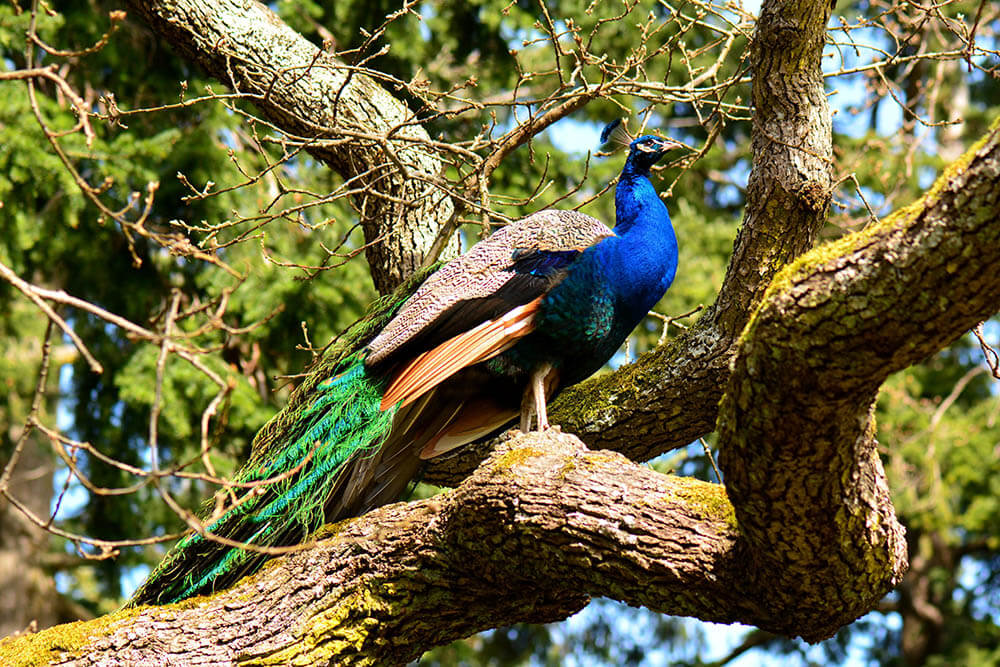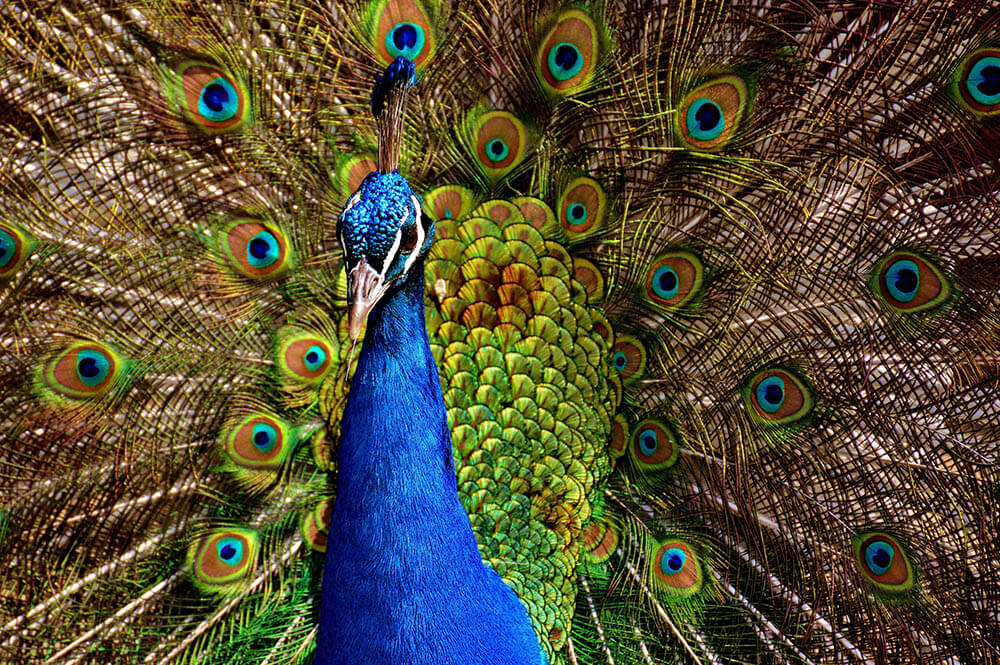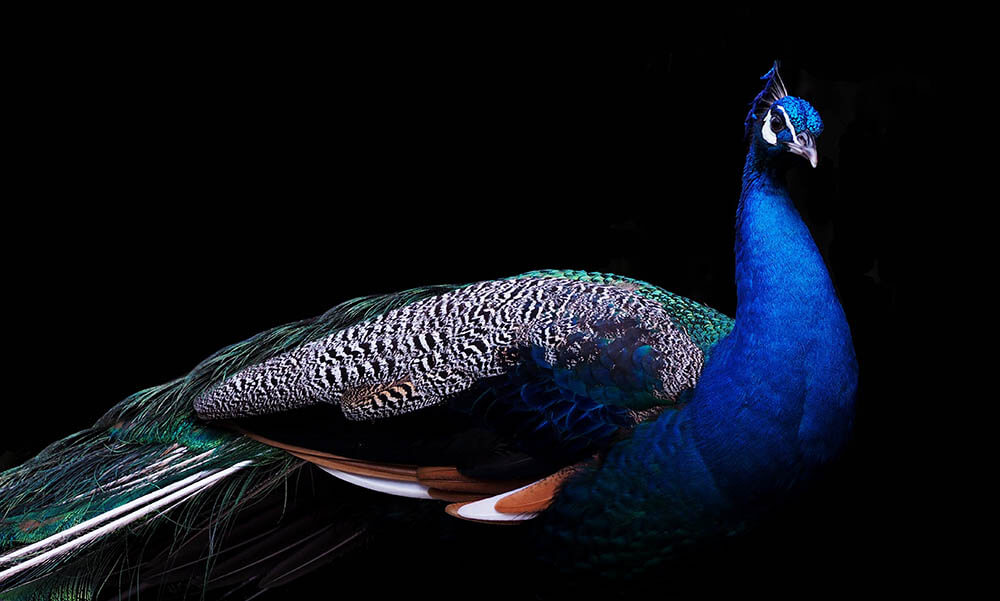With their magnificent tail feathers and brilliant colors, peafowl are among the most beautiful birds in the world. And what would be more amazing than seeing such a beautiful creature in flight?
Unfortunately, we’re going to have to disappoint you. While flying is something peafowl are capable of, it isn’t their greatest strength. These birds prefer to stay on the ground, where they can forage for edibles and show off their gorgeous feathers to their admirers.
Want to know more about what flying is like for peafowl? Then keep reading!
Note: while these birds are popularly known as “peacocks,” the proper, gender-neutral term for the species is “peafowl.” Peacocks are male peafowl, while peahens are female peafowl.

Peafowl Flight Facts
Contrary to popular belief, peafowl aren’t flightless birds, so yes, they do fly.
However, they don’t use this ability to travel great distances as most other birds do. They don’t migrate from one location to another when the season turns, either. And when hungry, they don’t soar through the air to search for prey below. In short…
Peafowl fly, but not like other birds
A peacock or peahen will fly only when immediate circumstances demand it. For example, if a peafowl senses that there’s a predator nearby, it can use those wings to fly up to a tree branch or any other high place where it can find shelter from danger. For this reason, peafowl also tend to sleep several meters above the ground at night. All things considered, these birds spend only around 2% of their time flying – a skill they aren’t even that good at.
In other words, flight is only the peafowl’s secondary means of locomotion (learn more about this species’ primary navigation method further below).
Peafowl don’t fly far or high
Peafowl flight isn’t very impressive.
To become airborne, a peafowl runs and jumps a couple of times until it attains the momentum necessary for flight. Once it does, it flaps its wings vigorously and kicks itself off the ground. This allows the bird to fly up to about eight feet, which is around twice its height.
Unfortunately, peafowl are fairly heavy and their bodies aren’t designed to keep them aloft for extended periods. For this reason, they usually fly for around 300 feet only before returning to land. This is comparable to what a turkey can achieve but considerably farther than what a chicken is capable of. Occasionally, however, a peafowl can fly for around a mile – the operative word here being occasionally.
If you’re wondering if a peafowl’s fabulous tail feathers have any effect on how high or far it can fly, they don’t.

Peafowl are slow flyers
When it comes to level (or vertical) flight, peafowl can reach speeds of around 10 miles per hour (mph). This is pretty depressing considering pigeons can achieve top speeds of 150 mph. Even turkeys (50 mph) and pheasants (60 mph) fare better.
Peafowl are only slightly faster than chickens (8.7 mph)!
As peafowl are almost always flying vertically and for only short durations, it’s difficult to say whether or not they can fly faster than 10 mph. Typically, birds fly the fastest when they’re diving. For example, the Peregrine Falcon can travel a modest 68 mph when traveling in level flight. When making a quick descent, however, it’s the fastest animal in the world at 242 mph (389 kilometers per hour).
Peafowl don’t need to dive like Peregrine Falcons do, so we have no reliable record of their diving speed. All they really need flight for is to ascend onto their roosts and get down from those roosts. Sometimes, they also use this ability to clear obstacles such as rivers.
The peafowl’s tail feathers also don’t have any significant effect on its flight speed.
Peafowl learn to fly early
Peafowl become capable of flight super early, as in within a couple of days of hatching. Mastering the basics, however, can take much longer.
Peahen mothers are responsible for training their chicks how to navigate their environment. A mother will take her offspring with her during foraging, which she’ll use as an opportunity to give them lessons on how to run. Come evening, she’ll then encourage them to practice flying. Mothers typically prioritize teaching their chicks such skills, as they’re necessary for survival.
Most young peafowl become capable flyers when they’re around six months old, which is also when their mothers abandon them.

All About Peafowl Locomotion
So we’ve established that peafowl don’t fly in the same way other birds do. So how do they travel? What is their primary mode of navigation?
Peafowl do a lot of walking. These birds stay in large groups; come morning, these groups subdivide into smaller units, each of which then explores an area to forage and hunt for food. They usually pause for a breather come mid-day before resuming their search. Once darkness falls, the various subgroups come together once more to conceal themselves amongst the trees to sleep.
In addition to letting them roam various areas to look for edibles, those feet also allow them to run at around 15 mph, which helps them get away from predators.
Do those feet have other uses?
A peafowl’s feet come with sharp talons that also serve as lethal weapons that it can use for self-defense. In fact, these birds are known to attack people and cause deep, painful lacerations and mental trauma in the form of pavophobia – the fear of peafowl. One peafowl attack even led to the unfortunate death of a fully grown human.
Those talons are useful in another crucial way – it helps them find food. Peafowl are closely related to chickens, turkeys, and pheasants, which means they have similar techniques when it comes to foraging and hunting for food. Peafowl typically rake the soil to unearth grubs and worms.
They also tear up flowers to look for snails and rip fruits and vegetables apart to access the delicious seeds within. And of course, those claws are also used to kill other edibles, such as small rodents, snakes, frogs, and lizards.
How about their tail feathers?
Peacocks are famous for their long, vibrant tail feathers, which they spread out in a fan whenever they want to impress potential mates. Those feathers aren’t just for show, however; they also serve as a defense mechanism. If a predator chases a peacock and grabs it by those feathers, said feathers easily detach from the bird without hurting it, giving it a few more precious seconds to fly up to a branch and escape.

Conclusion
Yes, peafowl can and do fly – they just don’t fly as often, as fast, or as high as many other birds do. Flight is generally used as a solution to an immediate concern, such as making a hasty escape from a predator or crossing a river. In the absence of such issues, these birds rely on their legs and feet to walk around.
Maybe the peafowl’s poor flying ability is just nature balancing things out. After all, these birds are already mesmerizingly beautiful; if they were excellent flyers, too, then that would simply be unfair!
